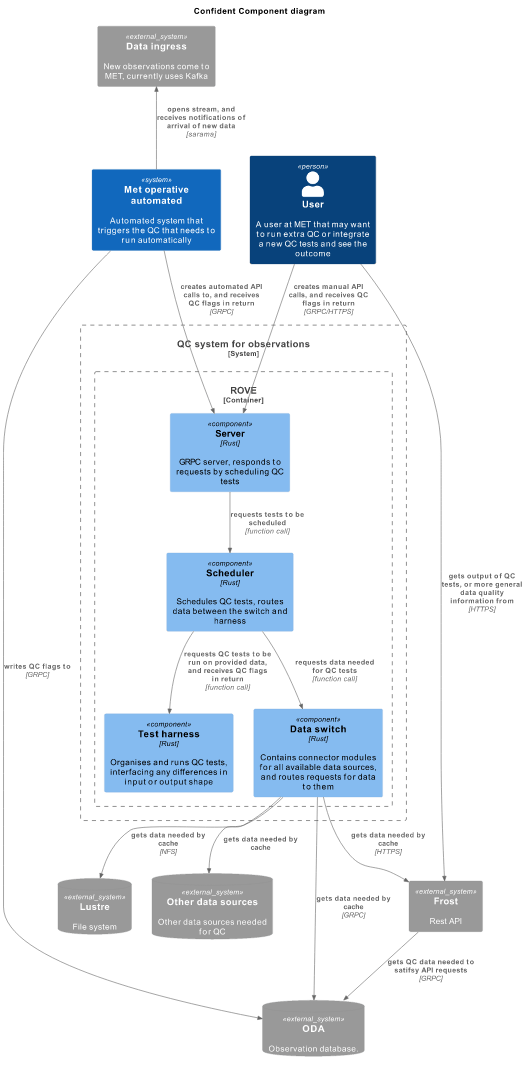3 unstable releases
| 0.2.1 | Apr 2, 2025 |
|---|---|
| 0.1.1 | Oct 19, 2023 |
| 0.1.0 | Oct 19, 2023 |
#26 in Geospatial
62 downloads per month
53KB
780 lines
Real-time Observation Validation Engine
What is ROVE?
ROVE is a system for performing real-time quality control (spatial and temporal) on weather data at scale. It was created to meet Met Norway's internal QC needs under the CONFIDENT project, and replace legacy systems. However, it was designed to be modular and generic enough to fit others' needs, and we hope it will see wider use.
Who is responsible?
Status
In alpha testing.
Benchmarks
Benchmarking code is available here.
There are three benchmarks:
- single, which spams ROVE with requests to run dip_check and step_check on a single piece of data each
- series, same as single except with 10k data points per request
- spatial, which spams requests for buddy_check and sct on 10k data points, distributed across a ~350x350km box
Here are the results run on an M1 mac:
single_benchmark thrpt: 53.036 Kelem/s
series_benchmark thrpt: 5.4106 Melem/s
spatial_benchmark thrpt: 194.01 Kelem/s
Kelem/s = thousand data points per second, M for million.
It is worth noting that ROVE scales horizontally. If you need more throughput than one node can provide, you can set up as many as you need behind a load balancer, though in most cases it's likely your bottleneck will be your data source.
Test it out
To use ROVE you need to generate bindings (a library that allows you to interact with the API) for the API in the language you want to use. The API definition can be found here.
The API has 2 endpoints:
- ValidateSeries, which performs timeseries QC tests, and takes arguments:
- series_id: a resource locator of the form :. e.g. oda:123456 where oda is a data source known to the system, and 123456 is a timeseries ID specific to oda
- start_time: timestamp representing the start of the subseries to be QCed. if not provided, the start of the time series will be used
- end time: timestamp representing the end of the subseries to be QCed. if not provided, the end of the time series will be used
- tests: list of the names of tests to be run on the data
- ValidateSpatial, which performs spatial QC tests, and takes arguments:
- spatial_id: a resource locator of the form : e.g. frost:air_temperature where frost is a data source known to the system, and air_temperature is an "element" in frost, specifying that we should only fetch air temperature data
- backing sources: extra data sources providing data to help qc the first source, but the data from these sources will not be qced themselves
- time: the timestamp of the spatial data to be QCed
- tests: list of the names of tests to be run on the data
- polygon: a list of lat-lon points defining a polygon, used to constrain the spatial slice to be QCed. if not provided, the whole slice will be QCed
Once you've set up bindings here's an example of how to use them to make a request to Met Norway's ROVE server in Python:
import grpc
import proto.rove_pb2 as rove
import proto.rove_pb2_grpc as rove_grpc
from proto.rove_pb2 import google_dot_protobuf_dot_timestamp__pb2 as ts
from datetime import datetime, timezone
def send_series(stub):
request = rove.ValidateSeriesRequest(
series_id="frost:18700/air_temperature",
start_time=ts.Timestamp(
seconds=int(datetime(2023, 6, 26, hour=14, tzinfo=timezone.utc).timestamp())
),
end_time=ts.Timestamp(
seconds=int(datetime(2023, 6, 26, hour=16, tzinfo=timezone.utc).timestamp())
),
tests=["dip_check", "step_check"],
)
print("Sending ValidateSeries request")
responses = stub.ValidateSeries(request)
print("Response:\n")
for response in responses:
print("Test name: ", response.test, "\n")
for result in response.results:
print(
" Time: ",
datetime.fromtimestamp(result.time.seconds, tz=timezone.utc),
)
print(" Flag: ", rove.Flag.Name(result.flag), "\n")
def send_spatial(stub):
request = rove.ValidateSpatialRequest(
spatial_id="frost:air_temperature",
time=ts.Timestamp(
seconds=int(datetime(2023, 6, 26, hour=14, tzinfo=timezone.utc).timestamp())
),
tests=["buddy_check", "sct"],
polygon=[
rove.GeoPoint(lat=59.93, lon=10.05),
rove.GeoPoint(lat=59.93, lon=11.0),
rove.GeoPoint(lat=60.25, lon=10.77),
],
)
print("Sending ValidateSpatial request")
responses = stub.ValidateSpatial(request)
print("Response:\n")
for response in responses:
print("Test name: ", response.test, "\n")
for result in response.results:
print(
" location: (lat: ",
result.location.lat,
" lon: ",
result.location.lon,
")",
)
print(" Flag: ", rove.Flag.Name(result.flag), "\n")
def main():
channel = grpc.insecure_channel("157.249.77.242:1337")
stub = rove_grpc.RoveStub(channel)
send_series(stub)
send_spatial(stub)
if __name__ == "__main__":
main()
Use it for production
Warning: ROVE is not yet production-ready.
You can set up your own ROVE instance connected to your own data source. It can work as either a gRPC server that receives requests over the network, or a component within a larger service, where QC runs are triggered by function calls. Examples of both are available in the documentation.
Of particular note, you will need to provide implementations of the DataConnector Trait so that ROVE knows how to talk to your data sources. Some real-world examples of DataConnector implementations can be found under met_connectors, where frost talks to a http REST API, and lustre_netatmo reads data from csv files over Network File System.
Overview of architecture
Documentation
Crate documentation is available here.
How to contribute as a developer
Contributions are welcome, contact Ingrid (ingridra@met.no).
Dependencies
~15–29MB
~481K SLoC
